 Larus cachinnans in the Netherlands
Larus cachinnans in the Netherlands
(last update: December 24, 2021)
Albert de Jong
Leon Kelder
Roland-Jan Buijs
Thijs Horst
Merijn Loeve
Mars Muusse
Cachinnans breeding in the Netherlands - species composition
| you can participate in this project too! please send in your observations of colour ringed birds to: ring@buijsecoconsult.nl |
ARE THOSE CASPIAN GULLS REALLY CASPIAN GULLS?
As mentioned in the section international trend, Caspian Gull, in their westwards expansion, are known for mixed pairing in areas where they meet Herring Gull, sometimes Yellow-legged Gull, and even Lesser Black-backed Gull. Offspring of such mixed couples may look similar to one of the parents, may show a combination of the parental features, or may in fact resemble a third species. And even more, those hybrid birds will eventually start breeding when adult, and may raise backcrosses, so-called 'F2 hybrids'. What to call birds in such a mixed population?
When ringing chicks in mixed colonies in Poland, it is impossible to ID each and every individual. Therefore, the Polish ringing scheme introduced a new category "Larus
cachinnans kolonia", for ringed chicks from colonies with Caspian Gull dominance, and those chicks which proved to have at least one Caspian Gull parent.
In analogy, "Larus argentatus kolonia" is used for ringed chicks from colonies with Herring Gull dominance, or when its known at least one parent is Herring Gull.
For other age class (non-chick ringed birds) a Polish life history may read "Herring Gull group Larus argentatus sensu lato" or "Larus
argentatus/cachinnans".
The situation is very similar in adjacent mixed colonies in east Germany. Whatever the category, ID is not immediately clear, and photographic evidence (e.g. from wintering grounds) is necessary to make any firm statements about an individual bird.
We have to accept we are dealing with birds from a contact zone. And with time, hybrids will raise F2, F3, etc backcrosses which eventually are impossible to tell from 'pure' birds, unless we know a birds complete pedigree.
In the Netherlands we call these head-scratching birds 'river' gulls, referring to the situation along the main inland river systems where four gull species meet and breed.
Jeroen Nagtegaal, ringer in southern Netherlands, has collected data on such birds, see HERE. As the project continues, he documented all weird kind of combinations, e.g.
- 2021 season: F1 hybrid Yellow-legged x Herring Gull male paired with Lesser Black-backed Gull female.
-
2019 season: Caspian Gull paired with Lesser Black-backed Gull, chicks ringed, but never reported yet.
- see thumbnails righthand side, for more breeding hybrid birds
trapped at the nest and ringed with yellow/blue combination tibia rings by Jeroen.
SPECIES CHARACTERISTICS
Lesser Black-backed Gull (Larus fuscus graellsii aka "Dutch intergrades")
- slate-grey upperparts, intense yellow legs, clear iris in most birds, large red gonydeal spot,
- elegant species, with long wings at rest, minority (males) is more bulky,
- most numerous breeder at both De Kreupel and Lelysyad.
Yellow-legged Gull (Larus michahellis)
- pale slate grey uppeprarts with blue cast, yellow legs,
- angular head shape, larger and bulkier than Lesser Black-backed Gull,
- incidental breeder in IJsselmeer district, in mixed pairs.
Herring Gull (Larus argentatus argenteus)
- pale silvery-grey on upperparts, commonly reduced black on P5, short pale tongue on P10 which commonly reach the edge gradually,
- yellow-orange orbital ring, stout fleshy pink legs,
- compact and short-winged, with angular head and fierce look by staring yellow eye,
- together with Lesser Black-backed Gull, the common breeding species in the Netherlands for decades.
Caspian Gull (Larus cachinnans)
- silvery-grey upperparts, orange-red orbital ring, often dark iris, long pale tongue on P10 and full band on P5
- large but still elegant, 'pencil-shaped' bill, long exposed tibia,
- new-comer, but numbers increase rapidly, and likely soon more numerous than Herring Gull.
"River" Gull - hybrids / Gibbins BB
- offspring of mixed breeders like Herring Gull x Caspian Gull, or Herring Gull x Yellow-legged Gull. "River" Gull named after offspring from nests at inland locations along the Dutch river-systems, where the above mentioned combinations have bred at various occasions.
POPULATION SIZE AT DE KREUPEL
| year / species | Lesser Black-backed Gull | Herring Gull | Caspian Gull | Yellow-legged Gull |
| 2004 | 0 | 1 | 0 | 0 |
| 2005 | 2 | 3 | 0 | 0 |
| 2006 | 3 | 4 | 0 | 0 |
| 2007 | 4 | 3 | 0 | 0 |
| 2008 | 3 | 6 | 0 | 0 |
| 2009 | 11 | 4 | 0 | 0 |
| 2010 | 15 | 11 | 0 | 0 |
| 2011 | 36 | 10 | 0 | 0 |
| 2012 | 79 | 24 | 0 | 0 |
| 2013 | 162 | 51 | 0 | 0 |
| 2014 | 141 | 40 | 1 | 0 |
| 2015 | 152 | 64 | 0 | 0 |
| 2016 | 141 | 52 | 0 | 0 |
| 2017 | 194 | 34 | 0 | 0 |
| 2018 | 223 | 70 | 2 | 1 |
| 2019 | 326 | 76 | 4 | 2 |
| 2020 | 429 | 45 | 15 | 1 |
| 2021 | 368 | 20 | 39 | 0 |
| table 1: number of observed individuals (not pairs, not necessarily breeding) of 3 gull species at colony Kreupel, the Netherlands. Note: decreasing numbers for Herring Gull may be related to the recent realisation we have to split the silvery-backed breeders into two species, Herring Gull and Caspian Gull. Also, breeding numbers for Herring Gull already fluctuated quite a lot, therefore we have to see if this is a 'genuine decrease' for that species. |
||||
POPULATION SIZE AT LELYSTAD
From the kayak, at approx 40 meters distance, we observed guarding birds on the breakwaters. We then landed, searched for the eggs and placed code flags on a bamboo stick near the nest.
We monitored 41 coded nests in 2020. Several nests appeared to belong to either Herring Gull or Lesser Black-backed Gull, and were subsequently skipped from the research.
A total of 32 nests had at least one parent Caspian Gull.
We also marked nest codes using paint spray, on blocks that were easily visible from the water.
For most nests, the substantial distance to neighbouring nests made countings easy. However, for some location we found clusters of nests, and especially in these clusters we may have missed breeding pairs.
In 2020, we did not estimate breeding numbers from the canoe, for neither Herring, nor Lesser Black-backed Gull at Lelystad.
However, the breeding gulls at Lelystad colony are counted annually from the airplane.
| year / species | Lesser Black-backed Gull | Herring Gull | Caspian Gull |
| 2015 | x | x | x |
| 2016 | x | x | 3 |
| 2017 | x | x | 1+ |
| 2018 | x | x | 3 (?) |
| 2019 | x | x | 13 |
| 2020 | x | x | 27 |
| 2021 | x | x | 41 |
| Table 1: Breeding gull species at colony Lelystad - Flevoland, the Netherlands. Caspian Gull pairs is with at least 1 partner = cachinnans. | |||
WHICH NESTS AT DE KREUPEL & LELYSTAD ARE CASPIAN GULL?
How to be sure a nest at De Kreupel or Lelystad belongs to Caspian Gull? We use the following steps.
- guarding birds at potential nest location
Obviously, Caspian Gull is a relatively early breeding species, and many birds arrive in March, when observing adults at nest locations is not hampered by tall green vegetation. Most guarding birds choose an obvious lookout post, visible from a distance, and attract attention by frequently alarming in a characteristic way and with diagnostic sound, ounce known.
- egg laying date
Apart from the phenotypics of guarding adults, another strong indication for Caspian Gull presence are the eggs. Egg laying date is obviously early for bulk of the breeding Caspians. We have collected data for egg laying date at colony Lelystad in season 2020 and season 2021. Result will be in the section BREEDING BIOLOGY.
Results for Lelystad 2020:
- average egg laying date for 21 selected Caspian nests is April 7th.
- average hatching date for 21 selected Caspian nests is May 9th.
- egg dimensions & pattern
Shell pattern on eggs is different (more contrasting than Herring) and egg dimensions are different (larger eggs than Herring).
Nests of Lesser Black-backed Gulls contain much smaller and browner eggs, and egg laying date is weeks later for that species.
- examining photographs
Many birds, alarming overhead, were photographed and details on head and wingtip were used to classify birds using the Chris Gibbins criteria (British Birds). Therefore, first estimations for the population size are assumed to be pretty accurate.
Ad point 4: in 2020 we collected data for all nests that were classified 'potential Caspian Gull nest'. We photographed the birds as much as possible, and examined each individual. The full table is HERE. Results for 2020 are summarised below.
| selected nests - species composition Lelystad | 2020 | 2021 |
| Caspian Gull | 37 | 59 |
| Caspian Gull sub-adult (not scored) | 5 | 0 |
| Caspian or hybrid (outside Herring range) | 2 | 3 |
| Herring or hybrid (outside Caspian range) | 4 | 5 |
| Herring Gull | 2 | 5 |
| Yellow-legged Gull | 0 | 1 |
| Hybrid Yellow-legged x Herring Gull | 0 | 1 |
| Breeding bird not scored (no pictures) | 6 | 12 |
| total | n = 56 | n = 86 |
species composition Lelystad of selected nests (table above)
- This is NOT the species composition for the whole colony, this is the compostion ONLY for selected nests
- As described earlier: nests were selected for:
- one/both of the birds guarding at lookout post seemed to be cachinnans
- a nests was built / eggs were present very early in the breeding season indicating cachinnans
- shell pattern of eggs & egg dimensions indicated cachinnans
- or (very often) a combination of these 3 points - For 2020, we estimate 44 Caspian Gulls or Caspian Gull hybrids in colony Lelystad
- For 2020, 85% (44 out of 50 scored birds in the sample) are classified Caspian Gull or Caspian Gull hybrid
- For 2021, we estimate 62 Caspian Gulls or Caspian Gull hybrids in colony Lelystad
- For 2021, 80% (62 out of 74 scored birds in the sample) are classified Caspian Gull or Caspian Gull hybrid
| selected nests - pair composition Lelystad | 2020 | 2021 |
| Caspian Gull pure pair | 16 | 24 |
| Caspian Gull with hybrid (outside Caspian range) | 4 | 2 |
| Caspian with Herring Gull | 2 | 3 |
| Caspian with Yellow-legged Gull | 0 | 1 |
| Hybrid (zy-MT) with Herring Gull | 0 | 1 |
| partner(s) not scored (no pictures) | 6 | 12 |
| total pairs | n = 28 | n = 43 |
pair composition Lelystad of selected nests (table above)
- This is NOT the pair composition for the whole colony, this is the compostion ONLY for selected nests
- Nest selection criteria for this sample: see above
- For 2020, we estimate at least 22, but up to to 28 nests involving Caspian Gull or Caspian Gull hybrid in colony Lelystad
- For 2021, we estimate at least 30, but up to to 42 nests involving Caspian Gull or Caspian Gull hybrid in colony Lelystad
general notes & remarks
- The ideal situation for us as researchers: guarding breeder + partner present, easy to photograph together, having a full clutch early in the season, with egg dimensions and patterns indicating Caspian Gull.
Easy peasy. Sometimes that happens, e.g. nest y-PA02, nest 29, or y-PHSV. - Fortunately, we have nests with both partners present "all the time" (seemingly). But in some nests not, and despite many visits we didn't manage to document a partner sufficiently.
You find this situation in the table under "Breeding bird not scored (no pictures)". How is that possible?
Examples are nest 17, with a female Herring Gull present all the time, but a partner never present (suspected Caspian Gull).
Or nest 55 with a perfect female Caspian Gull, but the partner was never seen, litterally. This nest failed eventually, so maybe there just "was no partner" for her? - Sometimes, a pair guarded a location "notoriously often". Why didn't they start to breed? Are these prospectors?
Floaters maybe?
In 2020 we had such a couple, both perfect Caspian Gull, called PAIR B. Litterally "always on their lookout spot".
Also in 2020, a Yellow-legged Gull bonded with Herring Gull g-97, called PAIR A. Always present, but not building a nest (as far as we know).
In 2021, again a mixed pair, now Yellow-legged Gull with Caspian Gull, always present at dam 2. And it took ages to start nest 41, which almost immediately failed.
Also worth mentioning is nest 60 - 62 - 63, very close together, with several Herring Gull nests within 3 steps distance, and a nice Blackberry complex for hiding the chicks, to picture the situation.
Nests this close together proved difficult to monitor, therefore uncertainties in the table with scores, below. Best option seems to trap breeding adults at the nest in 2022, and ring these birds. - Some nests we just had to let go. For example, a bird deep down in a Blackberry complex (nest 16B). Or close to Spoonbills (nest 40).
Illustrative is nest 53, of which we have no certainty about the parents. But we managed to ring chicks, which were reported back (see link).
They nest at T-split dam 1, a 'challenging' situation: loads of Lesser Black-backed Gull nest here, deep down between blocks, invisible from the canoe, and close to a dense Spoonbill section.
 Caspian Gull cachinnans P:U60 4CY, May 15 2021, Lelystad, the Netherlands. Parent of nest P:U60.
Caspian Gull cachinnans P:U60 4CY, May 15 2021, Lelystad, the Netherlands. Parent of nest P:U60. This image illustrates the situation in colony Lelystad: Caspian Gull breeding together with Herring and Lesser Black-backed Gulls.
 Mixed flock of gulls at artificial breakwaters, Lelystad, the Netherlands.
Mixed flock of gulls at artificial breakwaters, Lelystad, the Netherlands. In this particular section at 'dam 1' all four species are breeding together: Herring, Lesser Black-backed, Yellow-legged and Caspian Gull.
 By far the dominant species in colony Lelystad: Lesser Black-backed Gull. In future, we plan to monitor long term trends and the interaction between Herring, Lesser Black-backed and Caspian Gulls in this mixed colony.
By far the dominant species in colony Lelystad: Lesser Black-backed Gull. In future, we plan to monitor long term trends and the interaction between Herring, Lesser Black-backed and Caspian Gulls in this mixed colony. Lesser Black-backed Gull graellsii 1.T 12CY, March 24 2021, Lelystad, the Netherlands.
Lesser Black-backed Gull graellsii 1.T 12CY, March 24 2021, Lelystad, the Netherlands. Ringed as pullus on July 01 2011 at Maasvlakte, the Netherlands, now breeding at Lelystad.
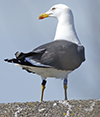 Lesser Black-backed Gull graellsii S.11 9CY, April 26 2021, Lelystad, the Netherlands.
Lesser Black-backed Gull graellsii S.11 9CY, April 26 2021, Lelystad, the Netherlands.Ringed as pullus on June 18 2014 at Maasvlakte, the Netherlands, now breeding at Lelystad.
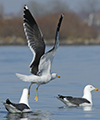 Lesser Black-backed Gull graellsii Y.BSN 9CY, March 24 2021, Lelystad, the Netherlands.
Lesser Black-backed Gull graellsii Y.BSN 9CY, March 24 2021, Lelystad, the Netherlands. Ringed as pullus on July 07 2014 at Forteiland - IJmuiden,Maasvlakte, the Netherlands.
Like the two Maasvlakte birds above, originally a bird from a coastal colony, now breeding at this rapidly growing inland location.
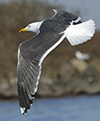 Lesser Black-backed Gull graellsii adult, March 30 2021, Lelystad, the Netherlands.
Lesser Black-backed Gull graellsii adult, March 30 2021, Lelystad, the Netherlands.Identification should be no problem.
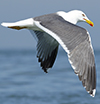 Lesser Black-backed Gull graellsii adult, June 08 2021, Lelystad, the Netherlands.
Lesser Black-backed Gull graellsii adult, June 08 2021, Lelystad, the Netherlands.A bird in the paler end of the spectrum, still obviously darker than Yellow-legged Gull michahellis.
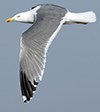 "River" Gull Larus spec. adult, March 30 2021, Lelystad, the Netherlands.
"River" Gull Larus spec. adult, March 30 2021, Lelystad, the Netherlands.River Gull captures all kind of hybrids of which parental identity is merely a guess, as in this bird. Here no black on P5 therefore one parent is probably Herring Gull, while pale-slate upperparts and much black on P9-P10 suggest the other parent to be Lesser Black-backed Gull (or maybe Yellow-legged Gull).
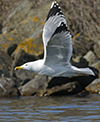 Yellow-legged Gull michahellis male from nest 41-2021, March 30 2021, Lelystad, the Netherlands.
Yellow-legged Gull michahellis male from nest 41-2021, March 30 2021, Lelystad, the Netherlands. Partner is female Caspian Gull cachinnans with yellow legs too. In 2021 the nest failed.
 Yellow-legged Gull michahellis has been known breeding in the Netherlands for decades. However, the strong increase in Europe in the 1990's never really materialised in our country. Still, it's not rare to find the species in colonies, especially along the major water systems, and often in mixed breeding. Here at Lelystad, a male Yellow-legged Gull bonded to 8CY Herring Gull 97.
Yellow-legged Gull michahellis has been known breeding in the Netherlands for decades. However, the strong increase in Europe in the 1990's never really materialised in our country. Still, it's not rare to find the species in colonies, especially along the major water systems, and often in mixed breeding. Here at Lelystad, a male Yellow-legged Gull bonded to 8CY Herring Gull 97.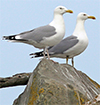 Yellow-legged Gull michahellis hybrid Z.M 9CY, March 30 2021, Lelystad, the Netherlands.
Yellow-legged Gull michahellis hybrid Z.M 9CY, March 30 2021, Lelystad, the Netherlands.Breeder at nest 54-2021, this is a female hybrid zy-MT (HY=2013), pullus from Wijk bij Duurstede colony, offspring from Herring x Yellow-legged Gull.
In lelystad, partner is Herring Gull. Offspring from nest 054 are "Herring Gull backcross F2-hybrids".

 Yellow-legged Gull michahellis -- / HM adult, May 11 2021, Stevol eiland, the Netherlands. Picture: Jeroen Nagtegaal ringing team.
Yellow-legged Gull michahellis -- / HM adult, May 11 2021, Stevol eiland, the Netherlands. Picture: Jeroen Nagtegaal ringing team.Partner is B/Y-HF michahellis
 F1 hybrid michahellis x argentatus -- / AL 4CY, May 11 2021, Stevol eiland, the Netherlands. Picture: Jeroen Nagtegaal ringing team.
F1 hybrid michahellis x argentatus -- / AL 4CY, May 11 2021, Stevol eiland, the Netherlands. Picture: Jeroen Nagtegaal ringing team. F1 hybrid michahellis x argentatus -- / CY adult, May 2019 & May 2021, Stevol eiland, the Netherlands. Picture: Jeroen Nagtegaal ringing team.
F1 hybrid michahellis x argentatus -- / CY adult, May 2019 & May 2021, Stevol eiland, the Netherlands. Picture: Jeroen Nagtegaal ringing team. Partner is B/Y-HH michahellis
 F1 hybrid michahellis x argentatus L||9 5CY, May 11 2021, Stevol eiland, the Netherlands. Picture: Jeroen Nagtegaal ringing team.
F1 hybrid michahellis x argentatus L||9 5CY, May 11 2021, Stevol eiland, the Netherlands. Picture: Jeroen Nagtegaal ringing team. probably F2 hybrid michahellis x argentatus X argentatus -- / HJ adult, May 11 2021, Stevol eiland, the Netherlands. Picture: Jeroen Nagtegaal ringing team.
probably F2 hybrid michahellis x argentatus X argentatus -- / HJ adult, May 11 2021, Stevol eiland, the Netherlands. Picture: Jeroen Nagtegaal ringing team.Partner is B/Y-HL probably F2 hybrid michahellis x argentatus X michahellis
 probably F2 hybrid michahellis x argentatus X michahellis -- / HL adult, May 11 2021, Stevol eiland, the Netherlands. Picture: Jeroen Nagtegaal ringing team.
probably F2 hybrid michahellis x argentatus X michahellis -- / HL adult, May 11 2021, Stevol eiland, the Netherlands. Picture: Jeroen Nagtegaal ringing team.Partner is B/Y-HJ probably F2 hybrid michahellis x argentatus X argentatus
 Herring Gull argenteus, May 29 2019, Lelystad, the Netherlands.
Herring Gull argenteus, May 29 2019, Lelystad, the Netherlands. Classic bird sporting silvery grey upperparts, fleshy pink legs, pale iris, much black on P10 and reduced black on P5.
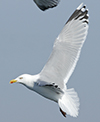 Herring Gull argenteus, March 24 2021, Lelystad, the Netherlands.
Herring Gull argenteus, March 24 2021, Lelystad, the Netherlands.Combination of features should pinch ID:
- stubby bill, staring yellow eye, orange-yellow orbital ring,
- pale silvery grey upperparts,
- much black on P10,
- (commonly) reduced black on P5,
- resting birds with compact body and short-winged impression.
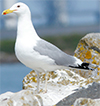 Caspian Gull cachinnans of nest 53-2021, May 15 2021, Lelystad, the Netherlands.
Caspian Gull cachinnans of nest 53-2021, May 15 2021, Lelystad, the Netherlands. Classic bird.
 Caspian Gull cachinnans male 'albatrossing' to an adult female Herring Gull argenteus, March 24 2021, Lelystad, the Netherlands.
Caspian Gull cachinnans male 'albatrossing' to an adult female Herring Gull argenteus, March 24 2021, Lelystad, the Netherlands. Note pale long tongue on P10 and dark iris.
 Caspian Gull cachinnans 201:U 6CY, May 20 2021, De Kreupel - D, the Netherlands. Picture: Leon Kelder.
Caspian Gull cachinnans 201:U 6CY, May 20 2021, De Kreupel - D, the Netherlands. Picture: Leon Kelder.Ringed as pullus on May 27 2016 at Nové Mlýny II reservoir, Czech Republic; breeder in the Netherlands now.
Parent of "nest 005" in season 2019 and 2020. Originally, ringed as pullus in Poland.
 Caspian Gull cachinnans 327:U 4CY, May 28 2021, Lelystad, the Netherlands. Picture: Albert de Jong.
Caspian Gull cachinnans 327:U 4CY, May 28 2021, Lelystad, the Netherlands. Picture: Albert de Jong.Inspecting the colony, or a breeder that has settled unnoticed? Originally, ringed as pullus in Czech Republic.